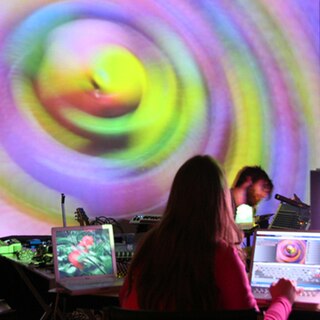Related Research Articles
Laurie Spiegel is an American composer. She has worked at Bell Laboratories, in computer graphics, and is known primarily for her electronic music compositions and her algorithmic composition software Music Mouse. She is also a guitarist and lutenist.

VJing is a broad designation for realtime visual performance. Characteristics of VJing are the creation or manipulation of imagery in realtime through technological mediation and for an audience, in synchronization to music. VJing often takes place at events such as concerts, nightclubs, music festivals and sometimes in combination with other performative arts. This results in a live multimedia performance that can include music, actors and dancers. The term VJing became popular in its association with MTV's Video Jockey but its origins date back to the New York club scene of the 1970s. In both situations VJing is the manipulation or selection of visuals, the same way DJing is a selection and manipulation of audio.

Daniel J. Sandin is an American video and computer graphics artist, designer and researcher. He is a Professor Emeritus of the School of Art & Design at University of Illinois at Chicago, and co-director of the Electronic Visualization Laboratory (EVL) at the University of Illinois at Chicago. He is an internationally recognized pioneer in computer graphics, electronic art and visualization.
Thomas Albert "Tom" DeFanti is an American computer graphics researcher and pioneer. His work has ranged from early computer animation, to scientific visualization, virtual reality, and grid computing. He is a distinguished professor of Computer Science at the University of Illinois at Chicago, and a research scientist at the California Institute for Telecommunications and Information Technology (Calit2).
The Electronic Visualization Laboratory (EVL) is an interdisciplinary research lab and graduate studies program at the University of Illinois at Chicago, bringing together faculty, students and staff primarily from the Art and Computer Science departments of UIC. The primary areas of research are in computer graphics, visualization, virtual and augmented reality, advanced networking, and media art. Graduates of EVL either earn a Masters or Doctoral degree in Computer Science.
Phil Morton (1945–2003) was an influential American video artist and activist who founded the Video Area in 1970 at the School of the Art Institute of Chicago, where he taught for many years.
Kathy Smith is an Australian independent animator, painter, new media artist, and Professor with the USC School of Cinematic Arts. Smith chaired the John C. Hench Division of Animation & Digital Arts from 2004 - 2009 & 2010 - 2014.

Video Data Bank (VDB) is an international video art distribution organization and resource in the United States for videos by and about contemporary artists. Located in Chicago, Illinois, VDB was founded at the School of the Art Institute of Chicago in 1976 at the inception of the media arts movement.
Larry Cuba is a computer-animation artist who became active in the late 1970s and early 1980s.
Julie Andreyev is a Vancouver-based multidisciplinary artist whose practice explores themes of animal agency and consciousness. Her ongoing Animal Lover work explores nonhuman animal agency and creativity through modes of interspecies collaboration and aleatoric methods. The Animal Lover projects seek to contribute towards an ethic of compassion and regard for the intrinsic worth of other-than-human individuals. She was born in Burnaby, British Columbia.
Jane Veeder is an American digital artist, filmmaker and educator. She is a professor at San Francisco State University in the Department of Design and Industry, at which she held the position of chair between 2012 and 2015. Veeder is best known for her pioneering work in early computer graphics, however she has also worked extensively with traditional art forms such as painting, ceramics, theatre, and photography.
Annette Louise Barbier was an American artist and educator. She worked with video art, net art, installation art, interactive performance, and emerging and experimental technologies since the 1970s. Themes in her work address "issues of home, defined locally as domesticity and more broadly as the ways in which we relate to our environment." An early work, "Home Invasion [1995]," incorporating critical dialogue and audio, is accessible from Leonardo. "Domestic space—formerly inviolable—is increasingly disrupted by electronic communication of all sorts, including radio, TV, email and the telephone." She was Chicago-based.
Kathy Rae Huffman is an American curator, writer, producer, researcher, lecturer and expert for video and media art. Since the early 1980s, Huffman is said to have helped establish video and new media art, online and interactive art, installation and performance art in the visual arts world. She has curated, written about, and coordinated events for numerous international art institutes, consulted and juried for festivals and alternative arts organisations. Huffman not only introduced video and digital computer art to museum exhibitions, she also pioneered tirelessly to bring television channels and video artists together, in order to show video artworks on TV. From the early 1990s until 2014, Huffman was based in Europe, and embraced early net art and interactive online environments, a curatorial practice that continues. In 1997, she co-founded the Faces mailing list and online community for women working with art, gender and technology. Till today, Huffman is working in the US, in Canada and in Europe.
Muriel Magenta née Zimmerman is an American visual artist working in new media genres of computer art, installation, multimedia performance as well as video and sculpture. Magenta is Professor of Art at Arizona State University.
Copper Giloth is a new media artist based in Amherst, Massachusetts. Giloth's work involves digital media, mobile art, virtual environments, animations, videos, painting, and installations, and have been influenced by elements of her life such as her parents. She, along with Darcy Gerbarg, helped organize art exhibitions that showed alongside the SIGGRAPH conference, marking the exhibitions as the first to be shown at the conference. Giloth has been described as "one of the leading exponents of computer art".
Bob Snyder is an American composer, sound and video artist, who lives and works in Chicago. His work focuses on the formal relations between electronic sounds and images, using synthesized visual and audio signals as his main medium. Throughout his career he has worked extensively with Sandin Image Processor, and his work has been featured in two Whitney Biennal exhibitions as well as institutions like the Museum of Modern Art, New York, the New York Public library and the Art Institute of Chicago. Several of his works have been made in collaboration with the artists Phil Morton, Tom DeFanti and Dan Sandin. Snyder is also the founder of the sound department at the School of the Art Institute of Chicago in its present form, where he was Professor Emeritus from 2016(?) until his retirement in 2022 after forty-six years at SAIC. He is the author of the book Music and Memory published by the MIT Press . He is also the author of the "Memory for Music" chapter in the 2009 and 2016 editions of the Oxford Handbook of Music Psychology. In 2020, Snyder contributed a chapter entitled “Repetitions and Silences: A Music and Memory Supplement” to the anthology Composition, Cognition, and Pedagogy, published by the Brazilian Association of Cognition and Musical Arts. (ABCM).
Colette Stuebe Bangert is an American artist and new media artist who has created both computer-generated and traditional artworks. Her computer-generated artworks are the product of a decades-long collaboration with her husband, Charles Jeffries "Jeff" Bangert (1938–2019), a mathematician and computer graphics programmer. Bangert's work in traditional media includes painting, drawing, watercolor and textiles.
Deanna Morse is an independent American experimental filmmaker and media artist. Her work is included in collections at the Metropolitan Museum of Art.

The Women's Interart Center was a New York City-based multidisciplinary arts organization conceived as an artists' collective in 1969 and formally delineated in 1970 under the auspices of Women Artists in Revolution (WAR) and Feminists in the Arts. In 1971, it found a permanent home on Manhattan's far West Side.

JoAnn Gillerman is an American multimedia artist and educator based in the San Francisco Bay Area. She is known for interdisciplinary, often interactive and immersive, works merging art, science, culture and technology. Gillerman emerged in the 1970s as an early new media artist, creating experimental combinations of video, collaborative live performance and installation. Art historian Liz Kotz wrote, "Gillerman pioneered the use of computer graphics and synthetically-generated imagery in video art … us[ing] the technology of computer-generated and re-processed images combined with electronic and acoustic music to develop different ways of making abstract visual designs." Since the 1990s, she has employed new technologies to produce interactive and educational environments, performances and works focused on cosmic events, natural phenomena and sociopolitical issues.
References
- 1 2 3 4 Cox, Donna J.; Sandor, Ellen; Fron, Janine (2018). New Media Futures: The Rise of Women in the Digital Arts. Chicago, IL: University of Illinois Press. p. 160. ISBN 978-0-252-04154-9.
- ↑ "Dan Sandin | Video Data Bank". www.vdb.org. Retrieved 2018-03-14.
- ↑ "COPY-IT-RIGHT - jonCates (2009)". Issuu. 11 October 2013. Retrieved 2020-04-28.
- 1 2 Golemis, Dean P. (December 15, 1986). "Instructor Achieves Acclaim". Columbia Chronicle. Retrieved 10 March 2019.
- 1 2 Warren, Lynn (1996). Art in Chicago, 1945-1995. Thames and Hudson. ISBN 9780500237281.
- 1 2 3 4 "Barbara Sykes". www.hi-beam.net. Retrieved 2018-03-09.
- ↑ "The Chicago Editing Center Newsletter (September - October 1981)" (PDF). mediaburn.org. Retrieved 18 March 2019.
- ↑ Warren, Lynne (1984). Alternative Spaces: A History in Chicago. Chicago, IL: Museum of Contemporary Art, Chicago. pp. 35–36. ISBN 0-933856-18-0.
- ↑ "The Third Australian Video Festival Program" (PDF). Retrieved 18 March 2019.
- ↑ Morris, Ed. "An Oral History Of Columbia College Chicago". An Oral History of Columbia College Chicago: 7.
- ↑ Guasco, Richard (1 April 1985). "Ace entries offer variety". Columbia Chronicle. Retrieved 10 March 2019.
- ↑ An Oral History Of Columbia College Chicago, Michael. "Neiderman" (PDF). An Oral History of Columbia College Chicago.
- ↑ "Brazilian Video Art To Be Shown". Chicago Tribune. April 8, 1988. Retrieved 2 March 2019.
- ↑ "Celebrating Women in New Media Arts". saic.edu. Retrieved 10 March 2019.
- ↑ Cates, Jon (2018). Chicago New Media, 1973-1992. Illinois: University of Illinois Press. p. 9. ISBN 978-0-252-08407-2.
- ↑ "Electronic Arts Intermix Video Collection List (as of Spring 1988)" (PDF).
- ↑ "Electronic Masks". YouTube . 17 December 2007.
- ↑ "By The Crimson Bands of Cyttorak". 13 January 2012.
- ↑ "Electronic Arts Intermix Video Collection List (as of Spring 1988)" (PDF).
- ↑ "Waking". ACM SIGGRAPH. Retrieved 2 March 2019.
- ↑ "I Dream of Dreaming". ACM SIGGRAPH. Retrieved 2 March 2019.
- ↑ "Witness". ACM SIGGRAPH. Retrieved 2 March 2019.
- ↑ "Kalyian".
- ↑ "d/stabilize/d - Media Burn Archive". Media Burn Archive. Retrieved 2018-03-14.
- ↑ "Shiva Darson".
- ↑ "A Song of the River".
- ↑ "A Documentary of a Living Saint".